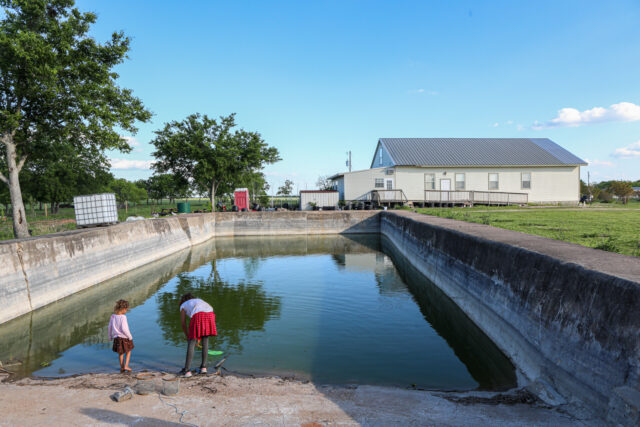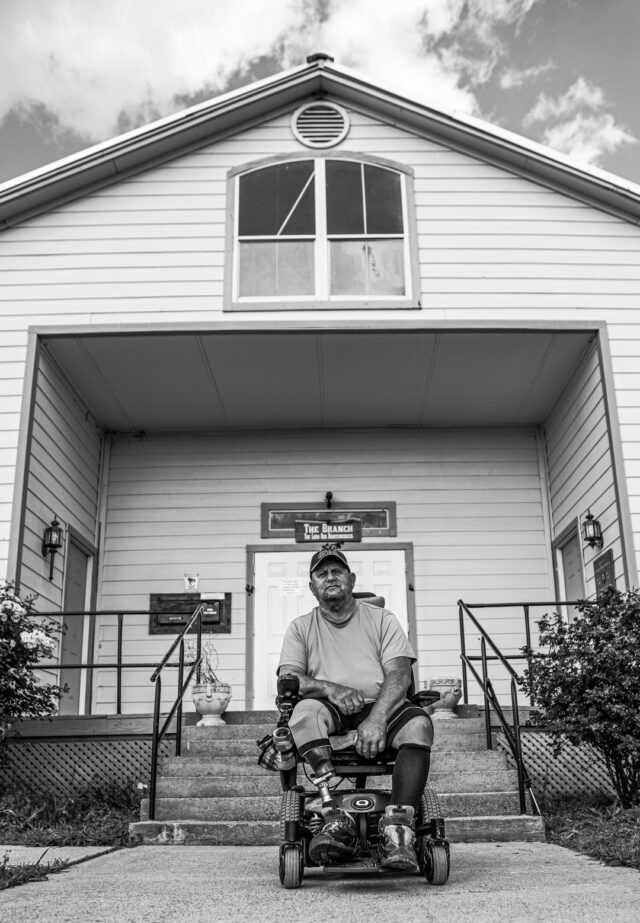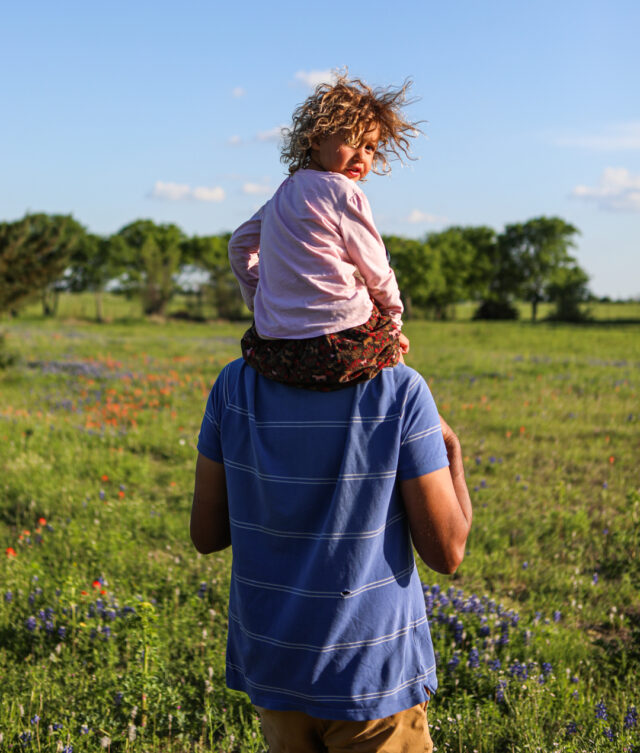By Rachel Royster | Editor-in-Chief
Just over 10 miles from Baylor’s campus, the 51-day standoff between the Branch Davidians and federal agents took place 30 years ago at the Mount Carmel Center.
To non-locals, Waco was once known for the birth of Dr Pepper, the Texas Sports Hall of Fame and the Texas Ranger Hall of Fame and Museum. Now, tourists’ top priorities are often Magnolia, Mount Carmel or both.
Mount Carmel has seen visitors from all over the United States and across the globe, including the Netherlands, Canada, Australia and Northern Ireland. According to Charles Pace, the current leader of the Branch community at Mount Carmel, the 77-acre plot of land gets around 200 visitors per week, with a jump to about 1,000 visitors on the day of former President Donald Trump’s campaign rally in Waco.
Where visitors now see a small one-room chapel with a Trump flag proudly waving outside, in 1993 a multi-story compound complete with a pool, storm shelter, chapel, vault and water tower stood before it and burned during the Waco Siege.

On Feb. 28, 1993, dozens of Bureau of Alcohol, Tobacco, Firearms and Explosives (ATF) agents spilled out of two cattle trailers fully armed, donning helmets and bulletproof vests. Their goal was to arrest David Koresh — the Branch Davidians’ leader who believed himself to be the Messiah — for stockpiling guns and explosives.
Not knowing which side shot first, the ATF agents and the Branch Davidians inside opened fire for two hours before calling a ceasefire. Four ATF agents and an unknown number of Branch Davidians were killed, and Koresh was injured.
After 51 days and about 215 hours of negotiation, the standoff ended with an FBI tank tearing through the walls of the compound to pump in tear gas before a fire was lit, burning the compound to the ground with 72 Branch Davidians inside.
No one knows who started the fire or who fired the first shot in those 51 days, but 30 years later, two Branch members who are living on the grounds and two journalists who covered the siege speak on what the 30th anniversary of the Waco Siege brings to mind for them.
Rod Aydelotte, Photographer at the Waco Tribune-Herald
Aydelotte is the current photo chief at the Waco Tribune-Herald and was one of the first journalists at the scene on Feb. 28, 1993. When he drove away in his new silver Honda after the shootout, there was a brand new bullet hole in the passenger side door.
“[The anniversary] doesn’t really stir up any emotions. People ask me that, but you know, I was just doing my job. It was crazy and went on forever — at least the siege. And then after the siege, it went on for years and years. I don’t really have any feelings about anything, so much as you get in situations like that, especially if you’re a journalist.
“When you get situations, it’s almost automatic. You don’t really let your emotions dictate. We were all automatic. The bigger problem I had was we were in the ditch. There’s a lot of firing for the first 30 or 40 minutes. It was cold, and then it started raining, and we got all wet. Every time we would look up, we got fired upon. Then the last time I looked up, there was a ceasefire, and all the agents were coming out. So we were walking down double E road, and I was more worried they were going to confiscate my film, so I was stuffing it everywhere I could in my pants. So eventually, we walked out with agents. And some were nice and some were harassing us, and I just didn’t know what to anticipate. I probably had about five or six rolls of film because there was no digital, and we processed that. And then my boss came in and said, ‘Somebody needs to get back out there.’
“I did have a really neat encounter on Feb. 28, when they had a ceremony for the ATF down by the Waco Suspension Bridge. I don’t know if you’ve seen any of my photos, but [in one of them], there’s a lead agent at the front door, gun up. Keep in mind, this has been 30 years, so I really have no contact with any of the ATF people. So out of the blue, weeks before the 28th, I got an email from a former FBI negotiator who wanted to get a reprint of that door. After trying to figure out if this guy was legit or not, I made a print and I took it down there and they had a ceremony for the ATF that we weren’t invited to. Frankly, they don’t really care for me. But long story short, I got to meet that guy. Turns out he was a really cool guy, and we talked for about 30 minutes about who fired first. And, of course, they say the Davidians fired first, which I believe that, but it was a really interesting moment to meet somebody famous in one of my photos that I’ve never met or never really thought I’d meet. We had a really great conversation about his perspective on when they approached the compound. That was a remarkable moment, since I never thought in the world I’d actually talk to any of those guys. So I hadn’t really told my story too much. I talked to him about it. That’s probably the more poignant part of the whole thing outside of being there.”

Charles Pace, Pastor at the Branch and Resident of Mount Carmel
Pace said he was a part of the Branch Davidians before and was ordained by Lois Roden, a president of the Branch Davidian Seventh-Day Adventist Church. He said he brought a prophecy to Koresh originally given by Ellen G. White, a co-founder of the Seventh-Day Adventist Church. Pace was not in Texas at the time of the standoff; he was trying to start his own religious movement from the time he left Mount Carmel in the 1980s until returning in 1994.
“[White] said that Ezekiel 28 was going to be fulfilled within the church. … I asked [Koresh], ‘Are you the man that she prophesied?’ And he said, ‘Yes, I am.’ I said, ‘Well, you understand what God’s going to do to that man?’ He says, ‘Yes, but I came. God raised me up to bring judgment on the church.’ I said, ‘You’re not only bringing judgment on the church, you’re bringing judgment on yourself. So are you willing to go through this judgment of God through the government and the army, and having your place burned down and all the men, women and children slaughtered, because you want to claim to be God?’ He says, ‘Somebody’s got to fulfill this prophecy for God. It might as well be me.’ He put his arm around my neck and turned around to the elders and looked them in the eye. And he said, ‘This brother is teaching truth. You better believe him.’ … So when the elders came the next day with a rebuttal of what I taught and what I said to David Koresh, they didn’t want to believe that. So because they didn’t want to believe that, they gave their wives and children to him. See, that’s how much they believed in the delusion that he was God and that he was having God’s children.
“We’re going to have a memorial service that I’m going to conduct [on Wednesday]. The Lord told me that this year, the 30th anniversary, I’m going to conduct the memorial finally, and I’m going to be able to say what I need to say. I’m going to tell everybody basically what really happened here. Hopefully, they understand and they will see that it’s true so that God is going to be honored — not just David Koresh.
“Whether people believe me or not, I don’t care. I don’t care if I’m a fool for God. I don’t mind being a fool. I’d be a fool not to be. So they can make fun of me all day long.”
Robert Darden, Emeritus Professor of Journalism at Baylor
Darden said Koresh often visited his office at the Waco Tribune-Herald before the standoff and invited him many times to play with the Branch Davidian band at Mount Carmel. Darden also co-authored the 1993 book “Mad Man in Waco: The Complete Story of the Davidian Cult, David Koresh and the Waco Massacre.”
“[During the siege,] everybody hated the FBI. I had a friend from high school who was highway patrol. They had multiple layers of security around [the compound]. The press was two miles away, essentially. But they had to do patrols closer. They had the satellite city, and then they had the command center for the FBI closer, and then pickets around even closer. Well, this guy said, ‘Hell, why don’t you come with me and we’ll go on patrol?’ And I said, ‘I can’t be there.’ And he said, ‘Just stay in the back of the seat. It’s after dark. When we get close, you can poke up and see what you want to see.’ So we did, and I was a nervous wreck because I’ve already run a file with the FBI guys. We got so close that I could see into the buildings, with the curtains flapping in the wind and people going about their business — having dinner like any suburban or rural farmhouse thing. … Tthat image — at night, cool breeze, it was spring, getting close, and illegally in a highway patrol car, and looking and seeing these people moving around like life hadn’t changed, just days away from an apocalypse — that sticks with me.”

Peter Christian, Groundskeeper and Resident of Mount Carmel
Christian said he has lived at Mount Carmel for about three years with his wife and children. He practices at The Branch, The Lord Our Righteousness, church under Pace. He said he tends to his “back to Eden” garden with plants ranging from onions to raspberries to moringa, which is also called the “tree of life.”
“This place is very beautiful because there is a peaceful spirit here. God is just, I think really blessing the whole place and helping us to do better as time goes on. I really think it’s just a great blessing to live here. But it can be difficult, because there’s a lot of people here — some who live here and some who come to visit. And of all the volume of people that we do get here, some people don’t always want to get along; they might not always want to agree.
“I really do believe that this place is blessed and that God really intends it to be a blessing for anybody who wants to be blessed by it. It’s really nice, but it’s kind of disguised because with all the tragic history that we do have here, it’s oftentimes associated with sadness and the loss that happened. But I think we’re living in a time when God is giving us a blessing instead of a curse.
“What I want to see improve more and more, as time goes on, is people just getting along, being able to understand each other. There’s a lot of contention sometimes about what happened here and who’s right and who’s wrong. From everything that I have learned, I don’t think either side was perfectly right or perfectly wrong. I think it was wrong on both sides, which is just kind of what human nature is.”





